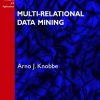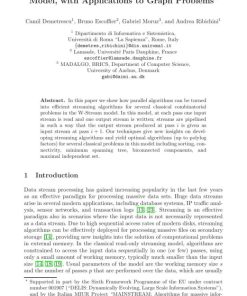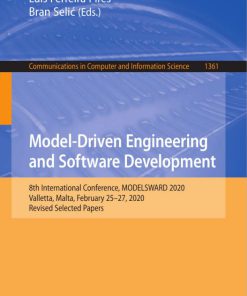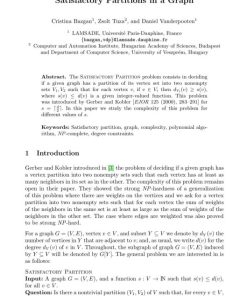Graph Transformations and Model Driven Engineering Essays Dedicated to Manfred Nagl on the Occasion of his 65th Birthday 1st Edition by Gregor Engels, Claus Lewerentz, Wilhelm Schafer, Andy Schurr, Bernhard Westfechtel ISBN 3642173225 9783642173226
$50.00 Original price was: $50.00.$25.00Current price is: $25.00.
Authors:Gregor Engels, Claus Lewerentz, Wilhelm Schäfer, Andy Schürr, Bernhard Westfechtel , Tags:Springer; 3642173217 9783642173219 , Author sort:Gregor Engels, Claus Lewerentz, Wilhelm Schäfer, Andy Schürr, Bernhard Westfechtel , Languages:Languages:eng , Published:Published:Dec 2010 , Comments:Comments:Springer
Graph Transformations and Model-Driven Engineering Essays Dedicated to Manfred Nagl on the Occasion of his 65th Birthday 1st Edition by Gregor Engels, Claus Lewerentz, Wilhelm Schäfer, Andy Schürr, Bernhard Westfechtel – Ebook PDF Instant Download/Delivery. 3642173225, 9783642173226
Full download Graph Transformations and Model-Driven Engineering Essays Dedicated to Manfred Nagl on the Occasion of his 65th Birthday 1st Edition after payment
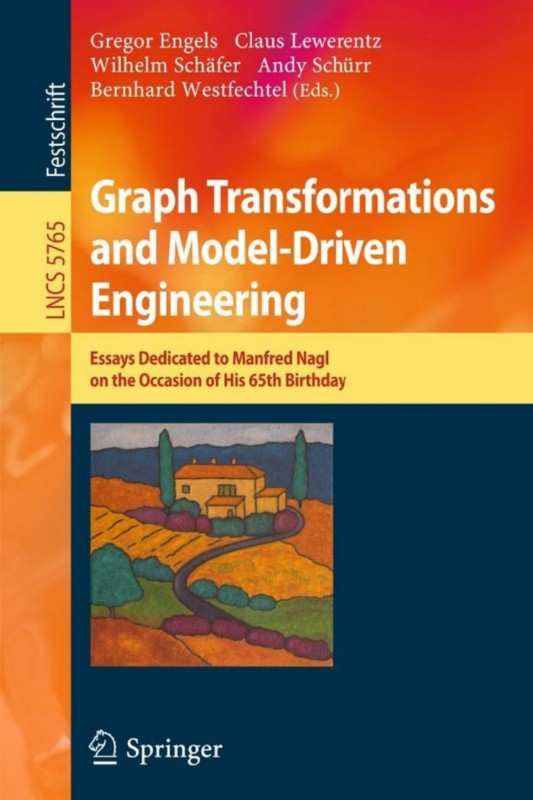
Product details:
ISBN 10: 3642173225
ISBN 13: 9783642173226
Author: Gregor Engels, Claus Lewerentz, Wilhelm Schäfer, Andy Schürr, Bernhard Westfechtel
This festschrift volume, published in honor of Manfred Nagl on the occasion of his 65th birthday, contains 30 refereed contributions, that cover graph transformations, software architectures and reengineering, embedded systems engineering, and more.
Graph Transformations and Model-Driven Engineering Essays Dedicated to Manfred Nagl on the Occasion of his 65th Birthday 1st Table of contents:
Graph Transformations and Model-Driven Engineering: The Merits of Manfred Nagl
Short CV
Research
Students
Publications
References
Graph Transformations: Theory and Applications
The Edge of Graph Transformation—Graphs for Behavioural Specification
Background
A Roadmap through the Graph Zoo
Nodes for Entities, Edges for Relations
Nodification
Edges for Structure, Nodes for Glue
The Awkwardness of Attributes
To Type or Not to Type
Special Graphs for Special Purposes
The Pushout Scare
Summary
Criteria for Behavioural Specification and Analysis
Learning Curve
Suitability
Flexibility
Scalability
Maturity
Tooling
Summary
Recommendations
References
Graph Transformation by Computational Category Theory
Introduction
Categories
Colimits
Graphs
Labeled Graphs
Graph Transformations
Conclusions
References
On GS-Monoidal Theories for Graphs with Nesting
Introduction
An Algebra for Graphs with Nesting and Restrictions
Graphs with Nesting and Restriction
The Algebra for Graphs with Nesting
A Normalised Form for Terms of AGN
Term Graphs and GS-Monoidal Theories
GS-Monoidal Theories
From AGN Terms to Term Graphs
From Term Graphs to Graphs with Nesting
Towards an Enhanced Modelling Framework
On Rewriting NR-Graphs
Edges with Inner Rank: From Term Graphs to GS-Graphs
Related Works
Conclusion and Further Works
References
Stochastic Modelling and Simulation of Mobile Systems
Introduction
Related Work
Case Study and Requirements
Generalised Stochastic Graph Transformation
The Base: Graph Transformation, Generically
The Topping: Stochastic Modelling with Global Time
Stochastic Simulation
From SGTS to Generalised Semi-Markov Processes
Algorithm and Tool for Stochastic Simulation
Conclusion
References
Autonomous Units and Their Semantics –The Concurrent Case
Introduction
Preliminaries
Concurrent Graph Transformation Approaches
Communities of Autonomous Units
Canonical Derivations
Related Work
Conclusion
References
Parallel Independence of Amalgamated Graph Transformations Applied to Model Transformation
Introduction
Example: Model Transformation from BPMN to BPEL by Amalgamated Graph Transformation
Type Graphs
A BPMN Instance Graph: ATM Machine
Transformation Rules
Amalgamated Graph Transformation
Parallel Independence of Amalgamated Graph Transformations
Related Work
Conclusions and Future Work
References
Extended Triple Graph Grammars with Efficient and Compatible Graph Translators
Introduction
TGGs with Negative Application Conditions
TGG Schema
TGG Productions
Simultaneous Evolution of Graph Triples
Language Translators Based on TGGs
Fundamental Properties of TGGs and Translators
Formalization of Constrained TGGs with NACs
Constrained and Typed Graph Grammars with NACs
Constrained and Typed Triple Graph Grammars with NACs
Dangling Edge Condition (DEC)
Formal introduction to LNCC and DEC
Dangling Edge Condition by Example
Extended Translation Algorithm with DEC
Related Work
Conclusion and Future Work
References
Controlling Reuse in Pattern-Based Model-to-Model Transformations
Introduction
Related Work
The Example Case Study
Preliminaries
Pattern-Based Model-to-Model Transformation
Considering the Meta-model Integrity Constraints
Generation of Operational Mechanisms
Parameterization and Heuristics for Rule Derivation
Check-Before-Enforce Semantics
Specification Process and Back to the Case Study
Conclusions and Future Work
References
Appendix
Lessons Learned from Building a Graph Transformation System
Introduction
Foundations: Metamodels
Model Transformations
Model Transformations via Efficient Graph Transformations
Practical Use of Model Transformations
The Issue of Verification
Transformations in Evolution and Adaptation
Summary and Conclusions
References
Workflow-Driven Tool Integration Using Model Transformations
Introduction
The Architecture of Tool Integration Chains
Classification of Development Activities
Synthesis
Analysis
Derivation
Process-Driven Tool Integration
Process Metamodel
Case Study: The DIANA Toolchain
Models
Overview of the DIANA System Modeling Process
Graph Transformation in the DIANA Tool Chain
Contracts as Graph Patterns
Example
Configuration Generation by Graph Transformation
Implementation of the Tool Integration Framework
Execution Architecture
Process Modeling Languages for Tool Integration
Related Work
Conclusion
References
Software Architectures and Reengineering
The Architecture Description Language MoDeL
Introduction
Architecture Views
Abstraction Types
The Static View
Functional Abstraction
Data Abstraction
Interface Extensions and Export Control
Module Relationships
Subsystems
Generics
Specifying Semantics
The Dynamic View
Concrete Architectures
Concurrency
Function Type Modules
Synchronization
Summary
References
Towards Managing Software Architectures with Ontologies
Introduction
Architecture Centric Development Processes
Requirements for an Architecture Design Language to Support the Consistency Checked Code Approach
An Example System
Concepts Language and Application Architecture
Platform Mapping
Ontologies as an Architecture Design Language
Benefits of Ontology-Based Modeling
Ontologies and Rule Systems
Ontology Specification Packages for Architecture Modeling
Concepts Consistency Analysis
Application Architecture Consistency Analysis
Architecture-Code Consistency Analysis
Modeling the Example with Ontology and Rule Languages
Modeling the Concepts Language and Checking for Satisfiability
Modeling the Application Architecture and Checking for Consistency
Modeling the Target Platform
Expressing the Platform Mapping
Checking for Architecture-Code Consistency
Related Work
Conclusion
References
Using Role-Play Diagrams to Improve Scenario Role-Play
Introduction
Modelling Object-Oriented Software
CRC-Cards
Role-Play Diagrams
The CRC/RPD-Process: Object-Oriented Analysis
Identify Candidate Classes
Filter Candidates
Create CRC-Cards
Allocate Responsibilities
Define Scenarios
Prepare Scenario Role-Play
The Actual Role-Play
Record Scenarios
Update CRC-Cards and Scenarios
The CRC/RPD-Process: Object-Oriented Design
An Example Step-by-Step
Find Candidate Classes
Filter Candidates
Create CRC-Cards and Allocate Responsibilities
Define Scenarios
Prepare Group Session
Carry Out and Record the Actual Role-Play
Possible Extensions or Improvements
Experience
Summary
References
Reverse Engineering Using Graph Queries
Introduction
Software
Terminology
Graphs
Pseudocode
Regular Expressions and Automata
Querying
Path Expressions
Definitions
Search Algorithms
Automaton-Driven Search Algorithms
Applications of Querying
Edge Inference
Call Graph Computation
Metrics Computation
Related Work
Conclusion
References
Graph-Based Structural Analysis for Telecommunication Systems
Introduction
Background
GSM Basics
The Programming Language PLEX
Execution Model
The E-CARES Environment
Program Analysis
Building the Structure Graph
Recovering Functions and Modules
Architecture Recovery
Motivation
Real-Time Object-Oriented Modeling Language
A Simple Mapping Algorithm
An Improved Mapping Algorithm
Realization
Related Work
Conclusion
References
Process Support
Do We Really Know How to Support Processes? Considerations and Reconstruction
Introduction
Requirements Analysis
Process Modeling
Process Execution
Supporting Domain Specific Process Modeling and Execution
Process Modeling Primitives
Domain Specific Process Modeling Constructs
Supporting Process Execution
Classification
Conclusion and Outlook
References
A Meta-Method for Defining Software Engineering Methods
Introduction
Core Concepts of Software Engineering Methods
Meta-Modeling for Software Engineering Methods
Method Engineering
Introduction to Method Engineering
Meta-Modeling for Method Engineering
SPEM
MetaME – A Meta-Method for Software Engineering Methods
Meta-Model Architecture of the Meta-Method
Method Engineering Meta-Method: Product Model
Method Engineering Meta-Method: Process Model
Integrating the Views of the Meta-Method
Defining the Artifact Model of Software Engineering Method
Software Process Modeling in the Software Engineering Method
Defining Work of Software Engineering Methods as Transformations
Tailorable Software Engineering Methodology
Conclusion
References
Techniques for Merging Views of Software Processes
Introduction
View Merging – The Basic Idea
Component Matching Algorithm
First Pass Score Computation
Second Pass Score Computation
Summary and Discussion of Component Matching
Inconsistency Management Algorithm
Discussion
Modeling Notation
Scalability
Related Work and Comparisons
Validation
Comparison Against Other Tools
Industrial-Scale Elicitation
Conclusion
References
Embedded Systems Engineering
Model Checking Programmable Router Configurations
Introduction
Programmable Routers
Modules
Rules
Connections
Configuration Update
Properties
Operational Semantics
Intermediate Representation
Promela Specification
Model Checking Promile
Abstractions to Reduce the State Space
Flow Generation
Proving Router Properties
Implementation
Evaluation
Related Work
Conclusions and Future Work
References
Architectural Issues of Adaptive Pervasive Systems
Introduction
Related Work
Scenario
TV On-Demand: Pay-Per-View Home Cinema
Service On-Demand: eHealth Emergency Management System
A Reference Meta-architecture
Scenario Implementation
Application and Environment Run-Time Models
Monitor
Decision Maker and Actuator
OSGi-Based Implementation
Conclusions
References
Using Graph Grammars for Modeling Wiring Harnesses – An Experience Report
Introduction
The Fujaba Process FUP
The OBA Application
The OBA Cost Model
Applying FUP Steps 1 and 2
Applying FUP Steps 3 and 4
Applying FUP Steps 5 through 8
Deployment
Other Approaches
Lessons Learned
References
Model-Driven Development with MECHATRONIC UML
Introduction
The Railcab Project
Architectural Model
Protocol Modeling
Controller Reconfiguration
Architecture Reconfiguration
The FUJABA Real-Time Tool Suite
Related Work
Current and Future Work
References
Model Synchronization at Work: Keeping SysML and AUTOSAR Models Consistent
Introduction
State of the Art
Model Synchronization
Model Integration
Application Example
SysML
AUTOSAR
Common Constituents
Approach
General Architecture
Architecture Example
Model Synchronization System Based on Triple Graph Grammars
Triple Graph Grammars
Model Transformation
Model Synchronization
Tool Adapter
Model Consistency
Usage Scenarios
Transformation from SysML to AUTOSAR
Repeated Forward Synchronization from SysML to AUTOSAR
Backward Synchronization from AUTOSAR to SysML
Iterative and Flexible Processes
Conclusion and Future Work
References
Multi-view Modeling to Support Embedded Systems Engineering in SysML
Introduction
Related Work
SysML as a Common Modeling Language for Multi-view Modeling
Multi-View Modeling Using SysML Profiles and Model Transformations
Example Problem Description
Formal Capture of Domain Knowledge Using Metamodels
Domain Specific Modeling in SysML
Model Transformations to Generate Domain-Specific Views
Discussion and Closure
References
Engineering Design Applications
Requirements Engineering in Complex Domains
Introduction
Requirements Engineering for Complex Software-Intensive Systems
COSMOD-RE: Brief Overview
COSMOD-RE Abstraction Layers
Co-development of Requirements and Architectural Artifacts
Further Reading and Outlook
Requirements Engineering in Community Networks
Community of Practice
Towards a Community RE Process
Discussion and Outlook
References
Tool Support for Dynamic Development Processes
Introduction
Related Work
Contributions
Structure of the Paper
The Process Management System AHEAD
System Overview
Dynamic Task Nets
Process Model Definitions
Process Model Evolution
Related Work
Using Workflows in Dynamic Processes
Motivation
Monitoring Workflows in Dynamic Processes
Weaving of a Workflow Fragment into a Dynamic Task Net
Workflow-Managed Dynamic Task Nets
Related Work
Adding Dynamics to Workflow Management Systems
Motivation
Simulating Dynamics
Dynamics Patterns
Related Work
Discussion
Domain-Specific vs. Domain-Independent Management System
Project vs. Workflow Management
A Priori vs. A Posteriori Integration
Barriers of Technology Adoption
Conclusion
References
An Extensible Modeling Language for the Representation of Work Processes in the Chemical and Process
Introduction
Requirements for a Modeling Language
Expressiveness
Formalization
Modeling Languages for Work Processes
Generic Modeling Languages
Specific Modeling Languages for Operational Processes
Specific Modeling Languages for Design Processes
Evaluation
Behavioral Semantics of WPML
Basic Elements of WPML
An Introductory Example
Basic Principles of the Formal Specification of WPML
Functional Modeling in WPML
Extensions for Operational Processes
Extensions for Design Processes
Integrating Process Behavior and Function
Implementation and Tool Support
Conclusions and Open Issues
References
Integration Tools for Consistency Management between Design Documents in Development Processes
Introduction
Overview of Integration Tools
Scenario and Motivation
Characterization of Document Relations and Tool Functionality
System Overview
Overall Integration Algorithm
Graph-Based Concepts
Triple Graph Grammars as Conceptual Basis
Interactive and Incremental Transformation
Interactive Repair Actions
Transfer to Practice: User Interfaces and Evaluation
Rule Modeling Support
User Interface for Integration
Time Complexity and Optimizations
Configuration of Integration Tools
Evaluation
Related Work
Conclusion
References
Towards Semantic Navigation in Mobile Robotics
Introduction
Semantic Navigation
Extracting Semantic Features from Documentation of Buildings
Data Models in AEC-Industry
Taking Advantage of Existing BIM
Adapting BIM for Mobile Robots
Extracting Semantic Features from Laser Scans
Converting Acquired Data into a 2D Image and Image Segmentation
Rapid Object Detection Using Haar-Like Features
Path Planning
Cellular Neural Network
Path Planning
Conclusions
References
Model Driven Engineering in Operative Industrial Process Control Environments
Introduction
Production Control Architecture
Plant-Related Control Tasks
Product-Related Control Tasks
Complete Structure
Software Architecture
Control Engineering in the Operation Phase
Towards a Methodical, Rule Assisted and Automated Engineering
Modeling the Engineering Process as a Series of Single Transformation Steps
Implementing an Engineering Service Architecture
Automated and Assisted Engineering Functionality
People also search for :Graph Transformations and Model-Driven Engineering Essays Dedicated to Manfred Nagl on the Occasion of his 65th Birthday 1st
graph transformations and model-driven engineering
graph transformations project
graph transformations example
graph transformation meaning
graph transformations definition


